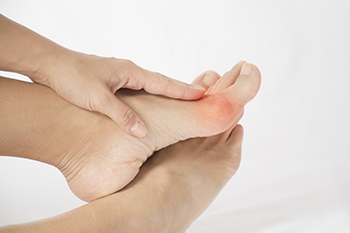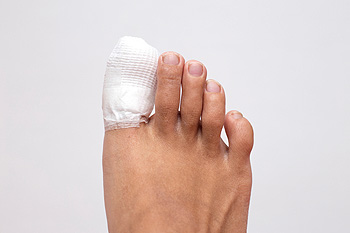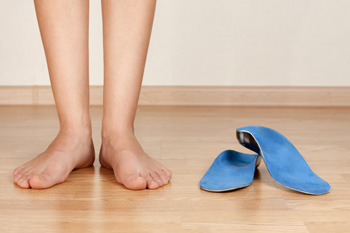Blog
Can Bunions Be Treated?
 The joint at the bottom of the big toe is often affected with an existing bunion. It can develop as a result of a misalignment of the big toe joint, and this can occur for a variety of reasons. These can include genetics, having flat feet, or from wearing shoes that do not fit properly. In severe bunions, the big toe may shift toward the other toes, which may cause pain and discomfort, in addition to possibly affecting proper balance. Larger shoes may need to be purchased that can accommodate the bunion. Surgery may be a necessary treatment option, and this can be successful in permanently removing the bunion. If you have developed a bunion, it is strongly suggested that you are under the care of a podiatrist who can help you with proper treatment decisions.
The joint at the bottom of the big toe is often affected with an existing bunion. It can develop as a result of a misalignment of the big toe joint, and this can occur for a variety of reasons. These can include genetics, having flat feet, or from wearing shoes that do not fit properly. In severe bunions, the big toe may shift toward the other toes, which may cause pain and discomfort, in addition to possibly affecting proper balance. Larger shoes may need to be purchased that can accommodate the bunion. Surgery may be a necessary treatment option, and this can be successful in permanently removing the bunion. If you have developed a bunion, it is strongly suggested that you are under the care of a podiatrist who can help you with proper treatment decisions.
If you are suffering from bunion pain, contact one of our podiatrists of James Kutchback, DPM, CWS-P. Our doctors can provide the care you need to keep you pain-free and on your feet.
What Is a Bunion?
Bunions are painful bony bumps that usually develop on the inside of the foot at the joint of the big toe. As the deformity increases over time, it may become painful to walk and wear shoes. Women are more likely to exacerbate existing bunions since they often wear tight, narrow shoes that shift their toes together. Bunion pain can be relieved by wearing wider shoes with enough room for the toes.
Causes
- Genetics – some people inherit feet that are more prone to bunion development
- Inflammatory Conditions - rheumatoid arthritis and polio may cause bunion development
Symptoms
- Redness and inflammation
- Pain and tenderness
- Callus or corns on the bump
- Restricted motion in the big toe
In order to diagnose your bunion, your podiatrist may ask about your medical history, symptoms, and general health. Your doctor might also order an x-ray to take a closer look at your feet. Nonsurgical treatment options include orthotics, padding, icing, changes in footwear, and medication. If nonsurgical treatments don’t alleviate your bunion pain, surgery may be necessary.
If you have any questions, please feel free to contact our offices located in The Woodlands and Woodville, TX . We offer the newest diagnostic and treatment technologies for all your foot care needs.
Stretching and Breathing Before Running
 Many running injuries can be prevented by properly warming up prior to jogging or running. This can be accomplished by performing leg swings and lunges, which are effective in increasing range of motion. Many people find it helpful to follow a running program. There are different facets to running, consisting of speed and endurance. It can help to focus on your breathing, and this time can be beneficial in deciding what the running goal is for the day. Using a foam roller on the hamstrings and ankles can help to loosen these areas, and posture may improve when stretches for the hip flexors are frequently performed. If you would like information about how to protect the feet before and after running, please consult with a podiatrist.
Many running injuries can be prevented by properly warming up prior to jogging or running. This can be accomplished by performing leg swings and lunges, which are effective in increasing range of motion. Many people find it helpful to follow a running program. There are different facets to running, consisting of speed and endurance. It can help to focus on your breathing, and this time can be beneficial in deciding what the running goal is for the day. Using a foam roller on the hamstrings and ankles can help to loosen these areas, and posture may improve when stretches for the hip flexors are frequently performed. If you would like information about how to protect the feet before and after running, please consult with a podiatrist.
Exercising your feet regularly with the proper foot wear is a great way to prevent injuries. If you have any concerns about your feet, contact one of our podiatrists of James Kutchback, DPM, CWS-P. Our doctors will treat your foot and ankle needs.
How to Prevent Running Injuries
Many common running injuries are caused by overuse and overtraining. When the back of the kneecap starts wearing out and starts causing pain in your knee, this is commonly referred to as runner’s knee. Runner’s knee is a decrease in strength in your quadriceps and can occur if you’re not wearing properly fitted or supporting shoes. To prevent runner’s knee, focusing on hip strengthening is a good idea, as well as strengthening your quads to keep the kneecaps aligned.
What Are Some Causes of Running Injuries?
- One cause of a common running injury is called iliotibial band syndrome.
- Plantar fasciitis is also another common injury.
- Stress fractures can occur from overtraining, lack of calcium, or even your running style.
Best Ways to Prevent Running Injuries
- Wear footwear that fits properly and suits your running needs.
- Running shoes are the only protective gear that runners have to safeguard them from injury.
- Make a training schedule. Adding strengthening exercises as well as regular stretching can help keep you strong and limber and can lessen the possibility of injuries.
- Stretching keeps muscles limber; this will help you gain better flexibility.
If you have any questions, please feel free to contact our offices located in The Woodlands and Woodville, TX . We offer the newest diagnostic and treatment technologies for all your foot care needs.
MTP Joint Replacement Surgery
The first metatarsal phalangeal or MTP joint refers to the joint of the big toe. Walking, running, wearing high heel shoes, and other activities can put increased stress on this joint. Furthermore, this joint is often affected by arthritis. Over time, the MTP joint can degenerate, causing pain, stiffness, and swelling. While there are several procedures that can be done to reduce pain in the MTP joint, only joint replacement restores motion to the affected toe. In this procedure, the damaged MTP joint is replaced with an implant. Recovery times vary, but patients will usually need to rest the affected foot for at least 6 weeks. For more information about MTP joint replacement surgery, please consult with a podiatrist.
In certain cases, in which the patient suffers from extreme pain or damage in a joint, joint replacement surgery may be deemed useful. If you have constant pain in a foot joint, consult with one of our podiatrists from James Kutchback, DPM, CWS-P. Our doctors will assess your condition and provide you with quality foot and ankle treatment.
What Is Joint Replacement Surgery?
Over time, joints wear down; this can be exacerbated by diseases and conditions. Joint replacement surgery, also known as arthroplasty, is when a damaged joint is surgically removed and replaced with a prosthesis. Prostheses, which can be made of ceramic, plastic, or metal, act as joints in lieu of an actual joint. One of the most prevalent causes for joint replacement is arthritis.
Arthritis in the Foot
Arthritis can occur in any joint in the body, including in the feet. Common types of arthritis in the foot are osteoarthritis, rheumatoid arthritis, and gout. The big toe is usually where arthritis occurs in the foot; this is known as hallux rigidus.
Joint Replacement Surgery in the Foot
The most common form of joint replacement in the foot is a first metatarsophalangeal (MTP) joint placement. MTP joint replacement surgery is designed to treat hallux rigidus. Surgery is not intensive, and recovery occurs within one to two months after the procedure has been done. Overall, joint replacement surgery is a safe and effective way to treat pain in the joint of the foot.
If you have any questions, please feel free to contact our offices located in The Woodlands and Woodville, TX . We offer the newest diagnostic and treatment technologies for all your foot care needs.
Reasons Why a Broken Toe Can Occur
 The majority of broken toes occur when it is stubbed against a piece of furniture, or when a heavy object is dropped on it. Immediate symptoms often include bruising, severe pain and discomfort, and it can be difficult to walk. A common treatment solution is referred to as buddy taping, and this is often used for mild fractures. This is accomplished by taping the affected toe to the toe next to it. This can help to provide the stability that is necessary for effective healing. It is beneficial to elevate the foot as frequently as possible, and healing may be accelerated when walking is limited. If you have broken your toe, it is strongly suggested that you speak with a podiatrist as quickly as possible who can determine what the best treatment is for you.
The majority of broken toes occur when it is stubbed against a piece of furniture, or when a heavy object is dropped on it. Immediate symptoms often include bruising, severe pain and discomfort, and it can be difficult to walk. A common treatment solution is referred to as buddy taping, and this is often used for mild fractures. This is accomplished by taping the affected toe to the toe next to it. This can help to provide the stability that is necessary for effective healing. It is beneficial to elevate the foot as frequently as possible, and healing may be accelerated when walking is limited. If you have broken your toe, it is strongly suggested that you speak with a podiatrist as quickly as possible who can determine what the best treatment is for you.
Broken toes may cause a lot of pain and should be treated as soon as possible. If you have any concerns about your feet, contact one of our podiatrists from James Kutchback, DPM, CWS-P. Our doctors will treat your foot and ankle needs.
What Is a Broken Toe?
A broken toe occurs when one or more of the toe bones of the foot are broken after an injury. Injuries such as stubbing your toe or dropping a heavy object on it may cause a toe fracture.
Symptoms of a Broken Toe
- Swelling
- Pain (with/without wearing shoes)
- Stiffness
- Nail Injury
Although the injured toe should be monitored daily, it is especially important to have a podiatrist look at your toe if you have severe symptoms. Some of these symptoms include worsening or new pain that is not relieved with medication, sores, redness, or open wounds near the toe.
If you have any questions please feel free to contact our offices located in The Woodlands and Woodville, TX . We offer the newest diagnostic tools and technology to treat your foot and ankle needs.
Basic Care to Keep Feet Healthy
 The majority of people take their feet for granted, until a foot condition occurs. The human foot consists of twenty six bones, in addition to several ligaments and tendons. It is beneficial to practice daily foot care, as this can help the feet to function properly. They are considered to be the foundation of the body, and it is important to keep the feet healthy. This can be accomplished by washing and drying the feet thoroughly, and applying a good moisturizer afterwards. This may help to prevent cracked heels from developing, which can cause pain and discomfort. When the toenails are trimmed properly, ingrown toenails may be prevented from forming. If you would like additional information about how to keep your feet healthy, please consult with a podiatrist.
The majority of people take their feet for granted, until a foot condition occurs. The human foot consists of twenty six bones, in addition to several ligaments and tendons. It is beneficial to practice daily foot care, as this can help the feet to function properly. They are considered to be the foundation of the body, and it is important to keep the feet healthy. This can be accomplished by washing and drying the feet thoroughly, and applying a good moisturizer afterwards. This may help to prevent cracked heels from developing, which can cause pain and discomfort. When the toenails are trimmed properly, ingrown toenails may be prevented from forming. If you would like additional information about how to keep your feet healthy, please consult with a podiatrist.
Everyday foot care is very important to prevent infection and other foot ailments. If you need your feet checked, contact one of our podiatrists from James Kutchback, DPM, CWS-P. Our doctors can provide the care you need to keep you pain-free and on your feet.
Everyday Foot Care
Often, people take care of their bodies, face and hair more so than they do for their feet. But the feet are a very important aspect of our bodies, and one that we should pay more attention to. Without our feet, we would not be able to perform most daily tasks.
It is best to check your feet regularly to make sure there are no new bruises or cuts that you may not have noticed before. For dry feet, moisturizer can easily be a remedy and can be applied as often as necessary to the affected areas. Wearing shoes that fit well can also help you maintain good foot health, as well as making it easier to walk and do daily activities without the stress or pain of ill-fitting shoes, high heels, or even flip flops. Wearing clean socks with closed shoes is important to ensure that sweat and bacteria do not accumulate within the shoe. Clean socks help to prevent Athlete’s foot, fungi problems, bad odors, and can absorb sweat.
If you have any questions, please feel free to contact our offices located in The Woodlands and Woodville, TX . We offer the newest diagnostic and treatment technologies for all your foot care needs.
Types Orthotics for Foot and Ankle Pain
 Orthotics are specialized shoes or heel inserts that are made to treat various foot and ankle problems. They can be bought over the counter at major retailers or be custom-made by a podiatrist. Different types of orthotics are designed to treat different types of foot and ankle problems. Full support shoe orthotics, such as orthotic inserts, splints, and traction devices, are useful for patients who have injuries associated with overuse, stress, or arthritis. Heel pads are a type of orthotic often used to correct foot overpronation, a type of gait where the foot rolls inward while standing or walking. Traction shoes or traction ankle supports are orthotic devices used to reduce pain and swelling from conditions such as bunions or ankle sprains. To see if orthotics are right for you, please consult with a podiatrist.
Orthotics are specialized shoes or heel inserts that are made to treat various foot and ankle problems. They can be bought over the counter at major retailers or be custom-made by a podiatrist. Different types of orthotics are designed to treat different types of foot and ankle problems. Full support shoe orthotics, such as orthotic inserts, splints, and traction devices, are useful for patients who have injuries associated with overuse, stress, or arthritis. Heel pads are a type of orthotic often used to correct foot overpronation, a type of gait where the foot rolls inward while standing or walking. Traction shoes or traction ankle supports are orthotic devices used to reduce pain and swelling from conditions such as bunions or ankle sprains. To see if orthotics are right for you, please consult with a podiatrist.
If you are having discomfort in your feet and would like to try orthotics, contact one of our podiatrists from James Kutchback, DPM, CWS-P. Our doctors can provide the care you need to keep you pain-free and on your feet.
What Are Orthotics?
Orthotics are inserts you can place into your shoes to help with a variety of foot problems such as flat feet or foot pain. Orthotics provide relief and comfort for minor foot and heel pain but can’t correct serious biomechanical problems in your feet.
Over-the-Counter Inserts
Orthotics come in a wide variety of over-the-counter inserts that are used to treat foot pain, heel pain, and minor problems. For example, arch supports can be inserted into your shoes to help correct overarched or flat feet, while gel insoles are often used because they provide comfort and relief from foot and heel pain by alleviating pressure.
Prescription Orthotics
If over-the-counter inserts don’t work for you or if you have a more severe foot concern, it is possible to have your podiatrist prescribe custom orthotics. These high-quality inserts are designed to treat problems such as abnormal motion, plantar fasciitis, and severe forms of heel pain. They can even be used to help patients suffering from diabetes by treating foot ulcers and painful calluses and are usually molded to your feet individually, which allows them to provide full support and comfort.
If you are experiencing minor to severe foot or heel pain, it’s recommended to speak with your podiatrist about the possibilities of using orthotics. A podiatrist can determine which type of orthotic is right for you and allow you to take the first steps towards being pain-free.
If you have any questions, please feel free to contact our offices located in The Woodlands and Woodville, TX . We offer the newest diagnostic and treatment technologies for all your foot care needs.
What Is Tarsal Tunnel Syndrome?
 Tendons, blood vessels, and nerves—such as the tibial nerve which provides feeling and mobility in the foot—travel through the tarsal tunnel in the ankle. When the tibial nerve gets constricted or damaged, Tarsal Tunnel Syndrome can occur. This condition produces tingling or numbness, pain, and a weakening in muscles and various parts of the foot. It can be triggered by swelling, abnormal growths in bones and joints, varicose veins, abnormal arches, and various systemic diseases. A complete recovery is possible if the condition is diagnosed and treated in its early stages. To avoid permanent complications such as pain, numbness, and immobility, it is suggested to consult with a podiatrist who can provide a variety of treatments and therapies.
Tendons, blood vessels, and nerves—such as the tibial nerve which provides feeling and mobility in the foot—travel through the tarsal tunnel in the ankle. When the tibial nerve gets constricted or damaged, Tarsal Tunnel Syndrome can occur. This condition produces tingling or numbness, pain, and a weakening in muscles and various parts of the foot. It can be triggered by swelling, abnormal growths in bones and joints, varicose veins, abnormal arches, and various systemic diseases. A complete recovery is possible if the condition is diagnosed and treated in its early stages. To avoid permanent complications such as pain, numbness, and immobility, it is suggested to consult with a podiatrist who can provide a variety of treatments and therapies.
Tarsal tunnel syndrome can be very uncomfortable to live with. If you are experiencing tarsal tunnel syndrome, contact one of our podiatrists of James Kutchback, DPM, CWS-P. Our doctors can provide the care you need to keep you pain-free and on your feet.
Tarsal Tunnel Syndrome
Tarsal tunnel syndrome, which can also be called tibial nerve dysfunction, is an uncommon condition of misfiring peripheral nerves in the foot. The tibial nerve is the peripheral nerve in the leg responsible for sensation and movement of the foot and calf muscles. In tarsal tunnel syndrome, the tibial nerve is damaged, causing problems with movement and feeling in the foot of the affected leg.
Common Cause of Tarsal Tunnel Syndrome
- Involves pressure or an injury, direct pressure on the tibial nerve for an extended period of time, sometimes caused by other body structures close by or near the knee.
- Diseases that damage nerves, including diabetes, may cause tarsal tunnel syndrome.
- At times, tarsal tunnel syndrome can appear without an obvious cause in some cases.
The Effects of Tarsal Tunnel Syndrome
- Different sensations, an afflicted person may experience pain, tingling, burning or other unusual sensations in the foot of the affected leg.
- The foot muscles, toes and ankle become weaker, and curling your toes or flexing your foot can become difficult.
- If condition worsens, infections and ulcers may develop on the foot that is experiencing the syndrome.
A physical exam of the leg can help identify the presence of tarsal tunnel syndrome. Medical tests, such as a nerve biopsy, are also used to diagnose the condition. Patients may receive physical therapy and prescriptive medication. In extreme cases, some may require surgery.
If you have any questions please contact our offices located in The Woodlands and Woodville, TX . We offer the newest diagnostic and treatment technologies for all your foot and ankle needs.
What Is Limb Salvage Surgery?
 Limb salvage surgery is a surgical procedure designed to prevent amputation of a limb. The main goal of this surgery is to save the limb, restore or improve its function, and help the patient return to their daily activities. Certain conditions may endanger your lower extremities and require surgery to prevent amputation of the affected limb. Specific types of bone fractures, advanced diabetic wounds, infections, cancers, frostbite, and poor circulation may need surgical intervention to save the affected limb. For more information about limb salvage surgery as it pertains to the lower extremities, please consult with a podiatrist.
Limb salvage surgery is a surgical procedure designed to prevent amputation of a limb. The main goal of this surgery is to save the limb, restore or improve its function, and help the patient return to their daily activities. Certain conditions may endanger your lower extremities and require surgery to prevent amputation of the affected limb. Specific types of bone fractures, advanced diabetic wounds, infections, cancers, frostbite, and poor circulation may need surgical intervention to save the affected limb. For more information about limb salvage surgery as it pertains to the lower extremities, please consult with a podiatrist.
Limb salvage can be an effective way in preventing the need for limb amputation. If you have diabetes, cancer, or any other condition that could lead to foot amputation if left unchecked, consult with one of our podiatrists from James Kutchback, DPM, CWS-P. Our doctors will assess your condition and provide you with quality foot and ankle treatment.
What Is Limb Salvage?
Limb salvage is the attempt of saving a limb, such as the foot from amputation. Podiatrists also try to make sure that there is enough function in the foot after the salvage that it is still usable. Diabetes is the number one cause of non-traumatic amputations in the United States. Those with diabetes experience poor blood circulation, which prevents proper healing of an ulcer. If the ulcer is left uncheck, it could become infected, which could result in the need for amputation.
However, there are other causes as well, such as cancer and traumatic injury. Links between higher mortality rates and amputation have been found. This translates into higher healthcare costs, and a reduced quality of life and mobility for amputees. Podiatrists have attempted to increase the prevalence of limb salvage in an attempt to solve these issues.
Diagnosis and Treatment
Limb salvage teams have grown in recent years that utilize a number of different treatments to save the infected limb. This includes podiatrists that specialize in wound care, rehabilitation, orthotics, and surgery. Through a combination of these methods, limb salvage has been found to be an effective treatment for infected limbs, and as an alternative to amputation. Podiatrists will first evaluate the potential for limb salvage and determine if the limb can be saved or must be amputated.
If you have any questions, please feel free to contact our offices located in The Woodlands and Woodville, TX . We offer the newest diagnostic and treatment technologies for all your foot care needs.






